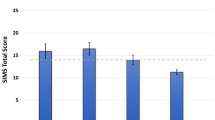Abstract
Purpose of review Self-report measures are common in clinical and research practice. These questionnaires permit fast evaluation of symptom severity and change over time and are sometimes used to identify the presence of possible psychiatric disorders. However, these measures may be less syndrome-specific than previously believed. In Iraq and Afghanistan-era veterans, the PTSD Checklist (PCL) and Beck Depression Inventory-II (BDI-II) are commonly used both clinically and in research due to high rates of posttraumatic stress disorder (PTSD) and depression. Clarity regarding the presumed specificity of such measures becomes important to interpretation of research results and application of psychiatric interventions. The current review intends to further this conversation.
Recent findings A recent paper found that the PCL-Military version and BDI-II were equally correlated to a diagnosis of PTSD per the gold standard clinician-administered PTSD scale. Using a research sample of Iraq and Afghanistan veterans, we found similar moderate to large correlations between both self-report measures and both diagnoses. A diagnosis of a depressive disorder was equally correlated with both the BDI-II and PCL.
Summary Results suggest that a third, underlying factor of general distress may be the target of each presumed syndrome-specific measure. Clinicians and researchers are encouraged to use such measures to assess distress or improvement following interventions rather than for diagnostic purposes.
Similar content being viewed by others
References and Recommended Reading
Papers of particular interest, published recently, have been highlighted as: • Of importance •• Of major importance
Schell TL, Marshall GN. Survey of individuals previously deployed for OEF/OIF. In: Tanielian T, Jaycox LH, editors. Invisible wounds of war: psychological and cognitive injuries, their consequences, and services to assist recovery. Santa Monica: RAND Center for Military Health Policy Research; 2008. p. 87–115.
Cifu DX, et al. Traumatic brain injury, posttraumatic stress disorder, and pain diagnoses in OIF/OEF/OND veterans. JRRD. 2013;50(9):1169–76.
Seal KH, et al. Bringing the war back home: mental health disorders among 103,788 US veterans returning from Iraq and Afghanistan seen at Department of Veterans Affairs facilities. Arch Int Med. 2007;167(5):476–82.
Diagnostic and statistical manual of mental disorders: DSM-5™. 5th ed. Arlington: American Psychiatric Publishing, Inc.; 2013.
Beck AT, Steer RA, Brown GK. Manual for the Beck Depression Inventory-II. San Antonio: Psychological Corporation; 1996.
Weathers F, et al. The PTSD checklist- military version. Boston: National Center for PTSD; 1994.
Weathers F, et al. The PTSD checklist (PCL) reliability, validity, and diagnostic utility. Presented at the Annual Convention of the International Society for Traumatic Stress Studies. San Antonio; 1993.
Erbes C, et al. Post-traumatic stress disorder and service utilization in a sample of service members from Iraq and Afghanistan. Mil Med. 2007;172(4):359–63.
Yeager DE, et al. Performance characteristics of the posttraumatic stress disorder checklist and SPAN in veterans affairs primary care settings. Gen Hosp Psychiatry. 2007;29(4):294–301.
Ben-Porath YS, Tellegen A. Minnesota multiphasic personality inventory-2 restructured form: manual for administration, scoring, and interpretation. Minneapolis: Pearson; 2011.
•• Arbisi PA, et al. The predictive validity of the PTSD checklist in a nonclinical sample of combat-exposed National Guard troops. Psychol Assess. 2012;24(4):1034–40. This study evaluated the ability of the BDI-II and PCL to predict PTSD diagnosis in a military sample and observed that both measures may be tapping a third, underlying construct of general distress.
• Wilkins KC, Lang AJ, Norman SB. Synthesis of the psychometric properties of the PTSD checklist (PCL) military, civilian, and specific versions. Depress Anxiety. 2011;28(7):596–606. This systematic review provides psychometric data on the military, civilian, and specific versions of the PCL including reliability, validity, and factor structure.
• Wortmann JH, et al. Psychometric analysis of the PTSD checklist-5 (PCL-5) among treatment-seeking military service members. Psychol Assess. 2016;28(11):1392–403. This study provides psychometric data on the updated PCL-5 including convergent and discriminant validity, and information on the factor structure.
Brancu M, et al. The Post-Deployment Mental Health (PDMH) study and repository: a multi-site study of US Afghanistan and Iraq era veterans. Int J Methods Psychiatr Res. 2017.
First MB, et al. Structured clinical interview for DSM-IV axis I disorders, Clinical Version (SCID-CV). Washington, DC: American Psychiatric Press, Inc.; 1996.
Acknowledgements
This research was supported by the resources of the W.G. “Bill” Hefner Veterans Affairs Medical Center and the Mid-Atlantic Mental Illness Research, Education, Clinical Center (MA-MIRECC).
Author information
Authors and Affiliations
Corresponding author
Ethics declarations
Disclaimer
The views expressed in this article are those of the authors and do not necessarily reflect the position or policy of the Department of Veterans Affairs, the Department of Defense, or the US government.
Conflict of Interest
Holly M. Miskey declares that she has no conflict of interest. Robert D. Shura declares that he has no conflict of interest.
Human and Animal Rights and Informed Consent
This article contains studies with human subjects. Studies were reviewed and approved by the local Institutional Review Board. Written and verbal informed consents were obtained from all participants. Welfare and privacy of human subjects were protected and maintained.
Additional information
This article is part of the Topical Collection on Post-Traumatic Stress Disorders
Rights and permissions
About this article
Cite this article
Miskey, H.M., Shura, R.D. Association of Self-Report Measures with PTSD and Depression in Veterans. Curr Treat Options Psych 4, 254–261 (2017). https://doi.org/10.1007/s40501-017-0120-2
Published:
Issue Date:
DOI: https://doi.org/10.1007/s40501-017-0120-2



